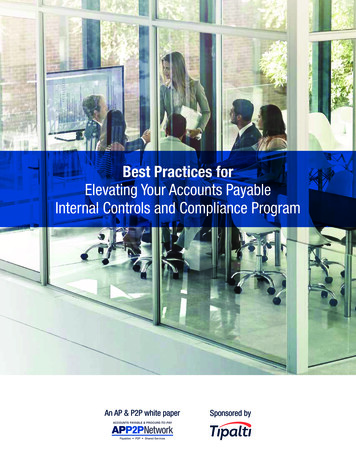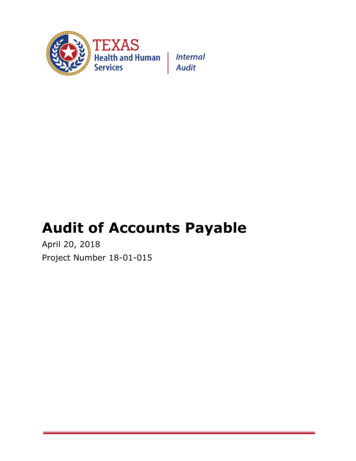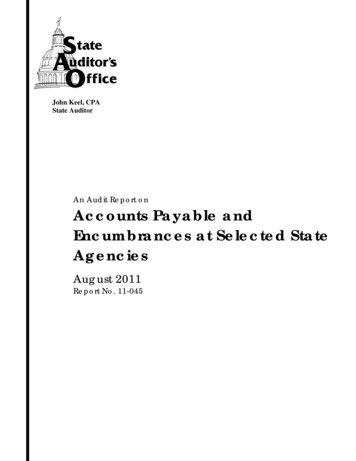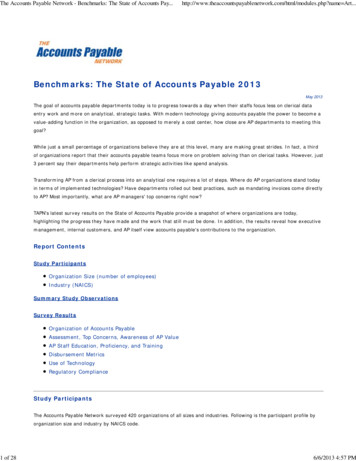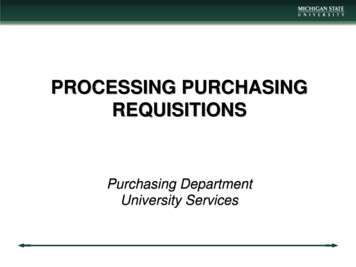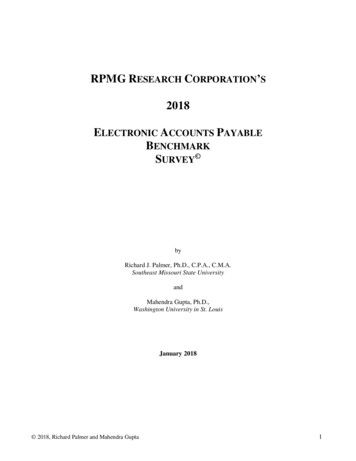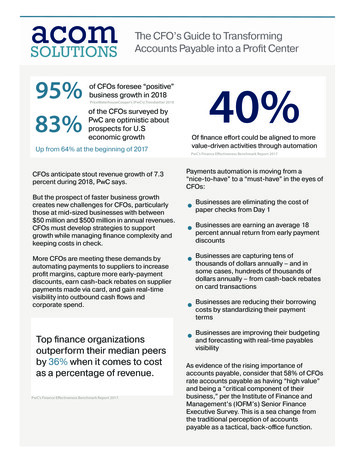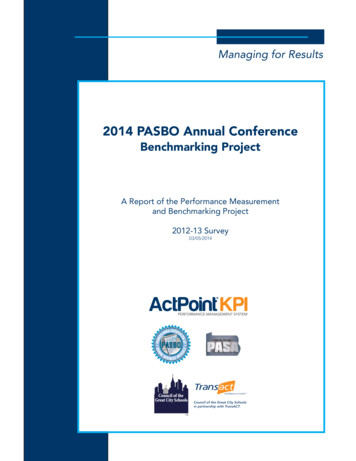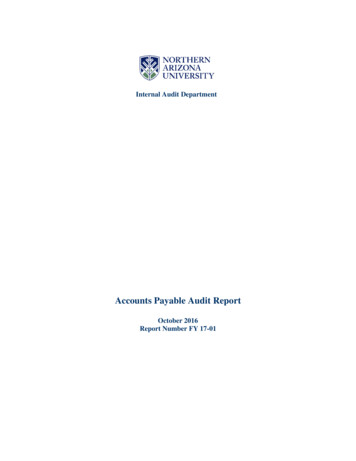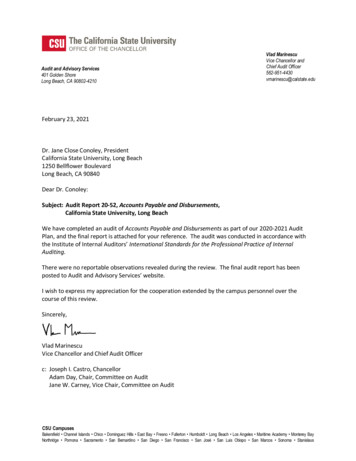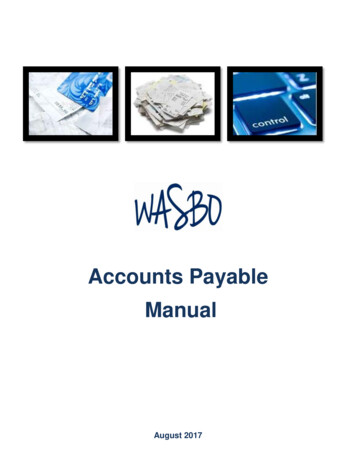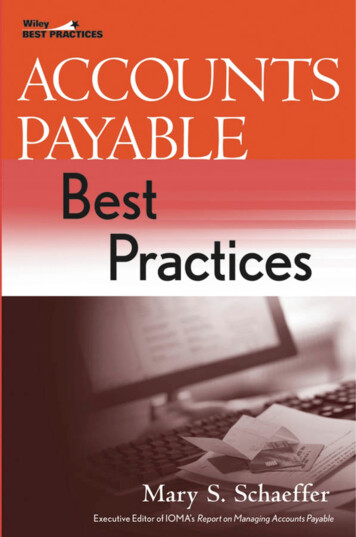
Transcription
Accounts PayableBest Practices
Accounts PayableBest PracticesMary S. SchaefferExecutive EditorIOMA’s Report on Managing Accounts PayableCo-creatorThe Accounts Payable Certification ProgramsJohn Wiley & Sons, Inc.
This book is printed on acid-free paper.Copyright 2004 by Mary S. Schaeffer and the Institute of Managementand Administration, New York, NY. All rights reserved.Published by John Wiley & Sons, Inc., Hoboken, New JerseyPublished simultaneously in CanadaNo part of this publication may be reproduced, stored in a retrieval system, ortransmitted in any form or by any means, electronic, mechanical, photocopying,recording, scanning, or otherwise, except as permitted under Section 107 or 108of the 1976 United States Copyright Act, without either the prior writtenpermission of the Publisher, or authorization through payment of the appropriateper-copy fee to the Copyright Clearance Center, Inc., 222 Rosewood Drive,Danvers, MA 01923, 978-750-8400, fax 978-646-8600, or on the Web atwww.copyright.com. Requests to the Publisher for permission should be addressedto the Permissions Department, John Wiley & Sons, Inc., 111 River Street,Hoboken, NJ 07030, 201-748-6011, fax 201-748-6008.Limit of Liability/Disclaimer of Warranty: While the publisher and author haveused their best efforts in preparing this book, they make no representations orwarranties with respect to the accuracy or completeness of the contents of thisbook and specifically disclaim any implied warranties of merchantability or fitnessfor a particular purpose. No warranty may be created or extended by salesrepresentatives or written sales materials. The advice and strategies containedherein may not be suitable for your situation. You should consult with aprofessional where appropriate. Neither the publisher nor author shall be liablefor any loss of profit or any other commercial damages, including but not limitedto special, incidental, consequential, or other damages.For general information on our other products and services, or technical support,please contact our Customer Care Department within the United States at 800762-2974, outside the United States at 317-572-3993 or fax 317-572-4002.Wiley also publishes its books in a variety of electronic formats. Some content thatappears in print may not be available in electronic books.For more information about Wiley products, visit our Web site at www.wiley.com.Library of Congress Cataloging-in-Publication Data:Schaeffer, Mary S.Accounts payable best practices / Mary S. Schaeffer.p. cm.“Published simultaneously in Canada.”Includes index.ISBN 0-471-63695-9 (cloth : alk. paper)1. Accounts payable. I. Title.HF5681.A27 S3 2004658.15′26—dc222003026689Printed in the United States of America10 9 8 7 6 5 4 3 2 1
For my candle in the wind,my father,Ron Schacht
ContentsIntroductionChapter 1Chapter 2xiInvoicesInvoice Handling: ApprovalsForwarding InvoicesVerifying Invoice DataInvoice-Coding StandardsShort-Paying InvoicesPaying Small-Dollar InvoicesHandling Unidentified InvoicesHandling Invoices without InvoiceNumbersCase Study: How One Pro Took AccountsPayable Out of the Picture whenResolving Customer DiscrepanciesChecksCheck PrintingCheck SigningCheck Stock StorageDistribution of ChecksCheck Fraudvii1168111619212325292935404245
ContentsChapter 3Chapter 4Chapter 5Rush or Emergency ChecksCase Study: Information Sheet:Segregation of Duties50OperationalDuplicate Payment AvoidancePaying When the Original InvoiceIs MissingLimiting Calls to Accounts PayablePetty CashSupplier StatementsCase Study: Expert DemonstratesHow to Put the Web to Workfor Accounts Payable5757Master Vendor FileMaster Vendor File SetupUsing Naming ConventionsMaking Changes to the Master Vendor FileMaster Vendor File CleanupCase Study: Experienced AccountsPayable Pro Shares Master VendorFile Control SecretsP-CardsDesign of the P-Card ProgramEstablishing ProceduresSetting ControlsIncreasing Usage1099s and P-CardsTermsRebatesCase Study: P-Cards Improve AccountsPayable Process at PETsMART,Rock-Tenn, and 8110111
ContentsChapter 6Travel and EntertainmentFormal PolicyCash AdvancesT&E Report FormVerifying DataHandling ReceiptsReservationsReimbursing EmployeesUnused TicketsCase Study: Making the Most of DirectDepositCase Study: TransUnion’s SuccessfulLow-Tech, Low-Budget T&E SolutionCase Study: Follow IBM’s Lead: 21Steps to an Award-WinningT&E ProcessCase Study: How Zurich AmericaDeveloped Its Own ElectronicT&E er 7Regulatory Issues1511099s151Sales and Use Tax154Unclaimed Property156Case Study: How to Avoid Salesand Use Tax Audit Disasters159Case Study: A Typical Company’s UnclaimedProperty Experience162Chapter 8Cash ManagementTaking Early Payment DiscountsPayment Status Information for VendorsBank Accounts and FraudOther Cash Management–RelatedInitiativesix167167170172174
ContentsCase Study: General Electric’s Approachto Electronic Invoicing and PaymentProcessingChapter 9Chapter 10TechnologyImaging and WorkflowThe InternetE-InvoicingCase Study: PPL Electric Offers Lessonson Setting Up an Accounts PayableImaging SolutionCase Study: An Accounts PayableWeb SiteCase Study: How the Accounts PayableManager at Merck OverhauledDepartment Proceduresand TechnologyCommunications/Customer RelationsPayment Status Information for VendorsCommunicating Relevant Informationto VendorsCommunicating with Internal CustomersImproving the Procure-to-Pay CycleCase Study: Interactive Voice ResponseFrees Accounts Payable from Annoying“Where’s My Money” CallsCase Study: How Automated AccountsPayable and Purchasing SystemsMesh at 9222229x
IntroductionCompanies should be interested in implementing best practices in their accounts payable (AP) operations for the samereason that Willy Sutton focused on banks—it’s where themoney is. The fundamental structure of the AP function isthat it is about a company’s financial integrity. Those who disregard their AP operations will adversely affect their bottomline, either directly by Paying invoices more than once Paying charges that should have been borne by the supplier Failing to take advantage of special pricing arrangements Not taking earned discounts Being fined by states for failing to comply with escheator sales and tax rulesor indirectly through Increased transactional costsIncreased costs to resolve discrepanciesIncreased costs to fix errorsIncreased costs by failing to take advantage of newprocesses and technologies Failing to earn early payment discountsxi
IntroductionOVERVIEW: FACTORSThe AP function has changed radically over the last 10 years,and it appears that the transformation will continue at leastfor the foreseeable future. The following are some of the factors affecting this transformation: Check fraud had reached levels that demanded not onlya change in the way companies write checks but also thetechnology used to limit the scams. Companies looking for ways to keep costs under controlhave cut AP staffs to the bone. Technology has made a big dent in the amount of resources companies now need to allocate to transactionalwork. The concentration in a growing number of accountspayable operations is shifting from transactional processing to an analytical focus. The overall number of people working in AP is declining. That decrease is almost entirely in the clerical staff.Consequently, the professional level of these departments is rising. States, desperate for ways to increase their coffers without alienating the voters, have found companies failingto comply with unclaimed property and sales and usetax rules to be just the answer to their problems. Theyare aggressively pursuing them and, when they findthem in noncompliance, auditing and fining them uncompromisingly. States now use third-party auditors inmany cases. They also work together. The accounting scandals and the enactment of the Sarbanes-Oxley Act have raised the level of inspection atmany companies, both private and public. The Internetxii
IntroductionBEST PRACTICE PRINCIPLESWith reduced resources and increased scrutiny, implementingbest practices in AP is more crucial than ever. Strictly focusingon cost is apt to get a company into trouble. While keepingcosts down is a good idea, it is important not to let that be theonly consideration. It is important that sufficient thought alsobe given to adequate controls, fraud prevention, and goodvendor relationships.To that end, in defining best practices, the following overriding principles will govern: Up-front controlsA move toward minimizing paperClear and easily traceable audit trailsMinimal clerical data entryTransactional efficiencyThis should translate into lower costs, in most instances.BEST PRACTICES IN A THEORETICAL BESTPRACTICE COMPANYIf it were possible to select best practices simply on the basisof what’s best and not taking into account corporate culture,existing procedures, financial limitations, and unique corporate procedures, here’s what the list might look like: Implement e-invoicing for all invoicing. Use positive pay. Insist that all purchase orders be completely filled outbefore they are issued, and that Receiving completelycheck packing slips. Use workflow to route invoices for reviews with an escalating approval structure.xiii
Introduction Have travel and entertainment (T&E) reports completed electronically; spot check rather than completelyreview each report; and make all employee reimbursements using direct deposit. Comply with all escheat and sales and use tax regulations. Make every payment possible electronically. Encourage all employees to be paid via direct deposit. Take advantage of all early payment discounts, but don’tmake any payments before the due date. Provide adequate resources for employee continuingeducation opportunities.IMPLEMENTING BEST ACCOUNTS PAYABLEPRACTICE POLICIESWhile the rest of this book examines AP functions in detailand spells out the best practices for each, this section will lookat some overall best practice policies: Minimize or eliminate low-dollar invoices. This can bedone through a variety of techniques, including:Use of purchase cards (p-cards)Making payments to certain vendors from statementsrather than invoicesE-invoicing Institute strong up-front controls, eliminating the mostback-end approval processes:Completely filled-out purchase ordersEvaluated receipt settlementNegative assurance Get rid of as much paper as possible using:Imaging䢇䢇䢇䢇䢇䢇䢇xiv
IntroductionE-invoicingA firm policy regarding where invoices should be sentfirstP-cardsConsider outsourcing specialty functions, including:Sales and use taxEscheatDuplicate payment auditsValue-added tax reclaimTelecom and freight payment and auditsMake as many payments as possible electronically, using:Direct depositAutomated clearinghouse credits and, where appropriate, debitsLimit the number of phone calls coming into AP by:Using online dispute resolutionUpdating payment status on the InternetUpdating payment status using interactive voice response (IVR)Publicizing payment timetablesIncluding an explanation slip with all short paymentsDon’t forget the value employees bring to the AP function:Motivate staffFocus on moraleAllocate some resources for staff education䢇䢇䢇 䢇䢇䢇䢇䢇 䢇䢇 䢇䢇䢇䢇䢇 䢇䢇䢇A WORD ABOUT BEST PRACTICESIt’s fine to talk about best practices in a theoretical sense, butprofessionals who toil in the field know that sometimes whatworks in theory will not work in their organization. Somexv
Introductiontimes industry peculiarities stand in the way, and other timesit might be the corporate culture or practices in another department. If the receiving dock does not do a good job atchecking packing slips, it is pointless to implement a processthat relies on accurate information from Receiving.Thus, in this book, you will see discussions of best practices as well as what we refer to as “almost best practices.”These take into account that not all practices will work at allcompanies and offer an alternative to those who cannot implement the absolutely best practices.We also include a discussion of those practices that definitely should not be used but, as many reading this knowfrom painful experience, are in use in parts of CorporateAmerica. Hopefully, by seeing these practices identified inprint, some will decide to replace them in their own organizations.WHAT’S INSIDEThe book starts at the beginning, reviewing the way invoicesare processed. It identifies a number of potential problem areas and then offers best practice solutions. Some of the itemsmay seem mundane to those not intimately familiar with AP.However, if they are ignored, expect duplicate payments andperhaps even fraud to increase.At least for the present, as most AP departments have notmade the leap to 100 percent electronic payments, checksdominate the payment landscape. If all aspects of this function are not handled properly, check fraud, duplicate payments, and processing costs will all increase. Also, the company may put itself in the position of being completely liablefor any check fraud that does occur.The mundane operational aspects of AP are reviewed in away that focuses attention on issues that are sometimes ignored. A complete chapter follows this on one of the most imxvi
Introductionportant, yet overlooked aspects of the purchase-to-pay cycle—the master vendor file. You would be surprised how often themaster vendor file is not even an issue on the table—with disastrous consequences. With the renewed interest in internalaudit and controls, thanks to the Sarbanes-Oxley Act, companies disregard their master vendor file at their own peril.P-cards are one of the easiest innovations to understand,and companies everywhere are adopting them. The potentialfor growth in this area is staggering. Thus, it is imperative thatthose who use them do so correctly. The cost and time savingswill be maximized if best practices are implemented from thebeginning.T&E is an area that has changed dramatically in the lastdecade. Online filing, the increased use of T&E cards, andother electronic initiatives have changed the way most of corporate America handles their T&E function. The chapter onT&E reveals some of the techniques used at innovative companies.While few people think of AP and regulatory issues in thesame breath, there are a few issues that, if not handled correctly, can bring trouble to a company. Specifically, in thischapter we take a look at 1099 reporting, sales and use taxhandling and reporting, and unclaimed property, also calledescheat. It is the last two areas, sometimes ignored by companies, that are drawing increased attention from the states.As the AP function becomes more analytical, it is inevitable that companies begin to expect that the professionalswho run AP take a cash management approach to the function. In some ways, paying too early is just as bad as paying toolate. This chapter takes a look at some of the cash management initiatives that are increasingly falling on the shouldersof the AP department.Although in many cases, AP was one of the last groupswithin some companies to get computers, they are making upfor it in a big way today. Technology is making inroads intoxvii
Introductionthe department in an extraordinary manner. This chaptershares some of those innovations. We expect this area to continue to expand, especially as AP takes the lead in pushing forelectronic invoicing and a move to electronic payments—away from the check standard.Finally, successful AP departments are starting to realizethat they have customers—both internal and external. Byfinding ways to deal with both, they are also improving vendorrelationships. Those that do not make this leap can hurt thevendor relationship and increase costs as poor communications with other departments run up the dispute resolutionbill.Upon looking back at the items covered, it is truly amazing how much AP has changed in the last 5 to 10 years. Thisbook attempts to identify the best practices that will makeyour AP department first rate.xviii
1InvoicesInvoices can present a real challenge to the payment function. If any of the aspects are not handled correctly, the payment process bogs down. In this chapter, we’ll look at䢇䢇䢇䢇䢇䢇䢇䢇Invoice handling: approvalsForwarding invoicesVerifying invoice dataInvoice-coding standardsShort-paying invoicesPaying small-dollar invoicesHandling unidentified invoicesHandling invoices without invoice numbersINVOICE HANDLING: APPROVALSBackgroundAs most reading this are well aware, Accounts Payable (AP)does a three-way match before paying an invoice. This entailsmatching the1
Accounts Payable Best Practices䢇䢇䢇Purchase order (PO)InvoicePacking slipIn theory, if all POs are filled out completely and correctly, ifreceiving thoroughly checks all packing slips, and vendors create accurate invoices, the AP department should be able to paythe invoice without input from any other party. However, fewcompanies are at this point. Even at those companies in whichthe documentation is good, management often demands thatthe original purchaser get involved and approve the invoicefor payment. Part of the reasoning for this is that often POsare not completely filled out and special pricing or paymentdeals are not reflected on the PO. Unfortunately, the purchaser who neglects to include special terms on the PO is justas likely to forget about them when the invoice shows up.With no formal policy governing where invoices are sent,first invoices sometimes float around the corporation, layingthe groundwork for all sorts of poor practices. For starters,the invoice often fails to arrive in any location that couldprocess it before the end of the early discount period. Additionally, it provides cover for those approvers who tend to letthe invoice lie on their desk for weeks without taking action.Then, when the supplier is threatening to put the companyon credit hold, these individuals deceitfully claim that they“sent that invoice down to Accounts Payable for processingweeks ago.”Recent innovations in the area of electronic invoicing arerapidly changing the way we think about invoices. This is reflected in some of the following recommendations.Best PracticesAt most companies, only certain people can approve invoicesfor payment. Most companies limit this ability by rank, job re2
Invoicessponsibility, type of purchase, and sometimes even the dollaramount. In the best of circumstances, the board of directorsshould have given these approvers authority, and AP shouldhave copies of these board authorizations.Copies of the list, if it exists in paper format, should begiven only to those who need it, and in all cases should befiled away carefully. The list should not be hung on the wallfor easy reference or left lying on a desk where anyone walking by could see it and easily make a copy. When the list is updated, as it periodically will be, old copies of the list should bedestroyed.If you want to be super careful, new copies of the listshould only be exchanged for the old ones, and all the oldones can be destroyed together.The fact that an invoice arrives in Accounts Payable with asenior executive’s signature on it does not mean that the senior executive actually approved the invoice. To protect theAP staff, the department should have signature cards containing the actual signature of anyone authorized to approve invoices. It should be the executive’s real signature, the one heor she uses every day, and not the Sunday-school signature.More than one executive has taken the time to sign a signature card carefully, when in actuality everything else has an illegible scrawl on it. In these cases, the signature card shouldhave the illegible scrawl as well, or the AP associate might suspect fraud when the signature cards are checked.We are not suggesting that these cards be checked forevery invoice that shows up. However, spot checking once in awhile is not a bad idea. And, obviously, if a suspicious-lookingsignature arrives on an invoice, the signature cards should bechecked immediately.Ideally, invoices will arrive electronically. Admittedly, today, only a small portion of invoices is received electronically,but that number is growing by leaps and bounds. When an invoice is received electronically, it should be forwarded to AP3
Accounts Payable Best Practicesfor processing. Using workflow, the AP department can forward the invoice for approval to the appropriate approver.This is based on information provided on the invoice integrated with the approver list discussed earlier.Companies should include in their workflow programmingan escalating approval feature. What this means is that if thefirst approver does not respond within a given time frame, sayfive days, the invoice is automatically routed to the next higherapprover in that chain of command. This not only takes careof tardy approvers, but also vacations and unexpected absences. It simultaneously creates an audit trail for everyone tosee. No longer can Purchasing claim it sent an invoice back toAP when it is still in the department. Finally, the audit trail feature combined with escalating approvals make it far less likelythat managers will relegate invoice approval to the bottom oftheir workload—especially when not approving invoices mayactually create more work for their immediate supervisors.When companies receive paper invoices, as virtually everycompany does, the invoices should be directed to AP ratherthan the individual purchasers. This allows AP to log the invoice in and forward it to the appropriate approver. It helps geta handle on the voluminous paper that can spread throughouta company without any boundaries. Ideally, when all invoicesare directed to AP, they can then be scanned and forwarded, asdescribed above, for approvals. Even if the intricate workflowprogramming is not feasible, there is still some audit trail andthe number of lost invoices is greatly reduced. The invoicenever leaves AP, and thus the “opportunity” to get lost on someone’s desk or in the mail is diminished. In order to make sucha process work efficiently, vendors should be directed to include the name of the purchaser on all invoices. Companiesthat make this process work the best are those that send invoices without the purchaser’s name back to the vendor.Having all invoices come first to AP also introduces another control against employee fraud. Invoices cannot be al4
Invoicestered, nor can they show up out of the blue with what lookslike an executive’s signature on them. By scanning the invoices and forwarding them for approval, it makes it all theharder for a scheming employee to forge a boss’s signature.Almost Best PracticesIn the absence of board authorizations, AP should have a listof who can approve what purchases. A high-level executive atthe company should sign off on this list. Otherwise, it is exceedingly easy to have fraud, and AP could end up taking ona responsibility it should not.If it is not possible to get imaging—even an inexpensivemodel—in AP, a policy still should be set up for receiving invoices. If all the invoices come to AP first, it will be necessaryto set up a log to track which invoices were received, their duedates, and whom they were sent to for approvals. This can bea tedious and time-consuming, paper-intensive process—ascopies should be made of the invoices before they are sentout for approval.Having the invoices come first to AP helps with the possible employee fraud issue discussed earlier.Reality Check for Accounts PayableWhile sending invoices lacking the purchaser’s name back tosuppliers may lead to a smoother AP operation, not all management teams are going to think this is a great idea—especially ifkey suppliers balk or complain. Thus, it might be a good ideato get management on board before instituting this policy.Worst PracticesWorst practices include䢇Having no policy regarding where invoices should besent for payment5
Accounts Payable Best Practices䢇䢇Not having a list of authorized approversAllowing anyone to submit invoices for payment.FORWARDING INVOICESBackgroundOn the face of it, it would seem that where invoices weremailed should have little impact on the payment function.Unfortunately, this is not the case. In a typical company withno invoice forwarding policy, invoices that are addressed tothe company but not a particular individual can float forweeks from desk to desk before eventually ending up in AP oron the desk of the purchaser. When invoices are not properlyrouted,䢇䢇䢇䢇Any chance of earning an early payment discount is lost.Duplicate payments can occur when a second invoice issent.Late fees can occur.Vendor relations are weakened.Best PracticesCompanies need to have a firm policy regarding where invoices should be sent. This can be one of two places:1. The AP department2. The original purchaserEither way works just as long as there is consistency in the approach. There is a slight advantage of directing all invoices toAP. When the invoices are sent directly to AP, a best practice isto insist that the purchaser’s name be included on the invoiceso the AP staff knows where to forward the invoice for approval. Some companies adhere to this approach, strictly re-6
Invoicesturning invoices to vendors if they arrive without the requestor’s name.The appeal of sending the invoice to AP first is that APcan easily track invoices. The downside is that, if electronic invoicing is not used, AP needs to make copies of the invoicesbefore forwarding them for approval unless the following areused:䢇䢇䢇ScanningNegative assuranceAssumed receiptIf the invoice is sent first to the original purchaser, AP mayfind itself inundated with “Where’s my money?” and “Did youget my invoice yet?” calls. However, many simply advise thecaller to telephone the purchaser.Electronic invoicing (e-invoicing) eliminates this problemcompletely.Almost Best PracticesDirect the mailroom to forward all invoices—regardless ofwhom they are addressed to—to the AP department for processing.Reality Check for Accounts PayableEven with the advent of e-invoicing, paper invoices will behere for the foreseeable future, although hopefully in smallernumbers. Thus, it is imperative that a policy for forwardinginvoices be established.Worst PracticesWorst practices include having no policy on this issue.7
Accounts Payable Best PracticesVERIFYING INVOICE DATABackgroundIn an ideal world a company would sell its customers productsand would in due course be paid for those goods according tothe prenegotiated payment terms, once the purchaser hadverified that it had received what it had ordered. (Some reading this may recognize this as the underlying principle of evaluated receipt settlement [ERS].) Unfortunately, there is a lotthat can and often does go wrong with this simple scenario.Some of the things that go awry include䢇䢇䢇䢇䢇䢇Terms on the invoice not matching what was negotiatedPartial shipmentsDamaged goodsPrices on the invoice not matching the negotiatedpricesInclusion or exclusion of related charges such asfreight, insurance, and so onSales and use tax charged/not chargedConsequently, the process for paying for goods can be complicated, especially when it comes to verifying the suppliers’ invoices.Best PracticesOnce the invoice has been approved (if that is required), athree-way match should be performed on all invoices oversome minimal level. Small-dollar invoices will be addressedfurther on. The AP associate should match the PO against theinvoice and packing slip to verify that the goods ordered havebeen received and the price and other fees (e.g., tax, insurance, freight) are as agreed.Differences must be resolved before the invoice can be8
Invoicespaid. If the difference is in the pricing, the better priceshould be taken. If the lower price happens to be on the PO,not only should the lower price be taken, but Purchasingshould be notified as well. The reasoning for this is that if alower price is put on an invoice, it probably indicates that thesupplier is offering a lower price to other customers and Purchasing should pursue that for your company.Accounts Payable can do a good job on this issue—especially when it comes to terms, insurance, freight, and so on—only if the PO is completely filled out. Often, Purchasing doesnot include special deals on the PO, and AP never knowsabout it. If the supplier does not include the special terms onthe invoice—and this often happens—AP will pay accordingto the standard terms or pricing, and the company is theloser. Thus, a best practice that needs to be emphasized withPurchasing is that POs must be completely filled out.The process described above can be done online. The bestsystems now have online dispute resolution features built in,especially when using e-invoicing.As mentioned earlier, some companies use a processknown as evaluated receipt settlement (ERS). This eliminatesthe invoice from the process—the document that many APprofessionals believe causes the most problems with the threeway match. Using ERS, the AP staff receives POs from Purchasing, and when it gets the packing slip from receiving, itpays according to the terms indicated on the PO. Companiesthat insist that the PO be completely and accurately filled outhave taken the first step toward being able to get rid of the invoice. If the PO line is under control and the professionals onthe receiving dock thoroughly check the packing slips on incoming orders, a company could effectively use ERS. Use ofERS has to be negotiated with suppliers before implementing.This is also known as pay-on-receipt.In addition to verifying that the PO matches the invoiceregarding price and other fees, many companies are now tak9
Accounts Payable Best Practicesing the verification process one step further with a contractmanagement function. As the title implie
Wiley also publishes its books in a variety of electronic formats. Some content that appears in print may not be available in electronic books. For more information about Wiley products, visit our Web site atww w.wiley.com. Library of Congress Cataloging-in-Publication Data: Schaeffer, Mary S
